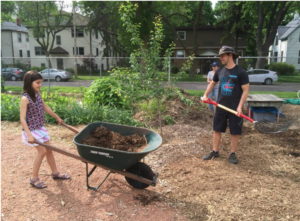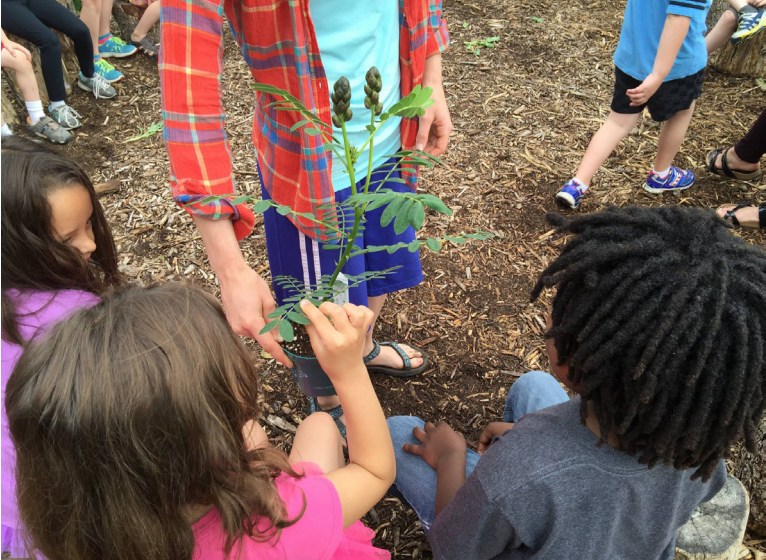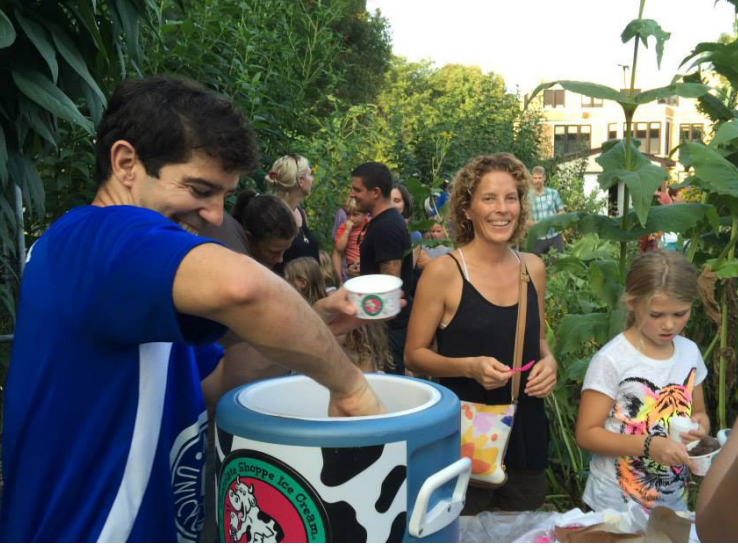Growing a Garden by Cultivating Relationships
 “Sometimes, there’s just a lot of luck,” explains Stephanie Steigerwaldt about the success of the school garden at Lapham Elementary School in Madison. But luck is only part of what makes the garden – and the kids who learn in it – blossom. Lapham’s garden is sustained by strong relationships with committed people in and beyond the school’s community, people like Steigerwaldt, who heads the school’s “Green Team” of volunteers.
“Sometimes, there’s just a lot of luck,” explains Stephanie Steigerwaldt about the success of the school garden at Lapham Elementary School in Madison. But luck is only part of what makes the garden – and the kids who learn in it – blossom. Lapham’s garden is sustained by strong relationships with committed people in and beyond the school’s community, people like Steigerwaldt, who heads the school’s “Green Team” of volunteers.
From the beginning, the garden has been a collaborative effort. It started in 1998 as a long rectangle of beds without much space to explore or gather. Thanks to support from teachers, parents, the community, and the school’s principal, the project was soon awarded grants. With help from the GROW grant, which funded fruit trees and rain barrels, and later the Art in the Garden grant, which funded permanent interactive installations, the garden has flourished. While the grants made these projects financially feasible, they also created a need for many hours of volunteer work.
Keeping volunteers organized and engaged can be a challenge. People come to gardening with a variety of time available and skill and interest levels. Part of Lapham’s success may come from its variety of volunteer opportunities. Parents can attend community work days, swing by the garden for an hour or two on the weekend, or even “adopt” the garden for a week in the summer. The entire community relies on efforts large and small. “There’s no way six people could maintain the 8008 square-foot garden otherwise!” says Steigerwaldt.
In 2012, spearheaded by a group of parents dedicated to enhancing the school’s capactiy for garden-based education, Lapham launched their gardener-in-residence program. The program is funded by Lapham’s parent-teacher group and managed by Community GroundWorks. The gardener-in-residence serves as a part-time coordinator and gardener. Among the position’s many roles are organizing classroom visits and clearly identifying what needs to be done in the garden. This year’s gardener-in-residence is Kim Mayer. She writes a list on the garden’s white board so that volunteering parents can come to the garden at their leisure without needing a supervisor to be present.
This method comes in handy not only for enterprising parents, but for the garden’s Master Gardener Volunteer. Master Gardeners were essential to developing the outdoor kitchen area and committing to difficult and laborious tasks. But Master Gardener Karen Klekamp has also incorporated her interest in issues of food sovereignty into her work with Lapham. In past years she has used information on the white board to determine what needed to be harvested from the garden. Each Tuesday, she harvested and delivered the garden’s produce to the local WilMar food pantry.
Of course, not everyone has the time and flexibility to volunteer in the garden. All members of the community are able to stay involved with the project through photographs and stories on the garden’s Facebook page. School-wide activities such as a fall potluck and ice cream social make the garden a communal space that has become part of the school’s culture. There is also a year-end letter and report that keeps parents, teachers, and community members up to date and acknowledges that the garden is possible thanks to the entire community.
In the end, the relationships cultivated through the garden grow a robust and well-integrated learning environment for the kids. Students are responsible for planting half to three-quarters of the garden. For children who were once hesitant to touch a plant or dig in the dirt, gardening becomes a normal part of their year, along with the ice cream socials and fall potlucks among the garden’s fruit trees, garden beds, and musical structures. “It’s a unique place,” Steigerwaldt says of Lapham Elementary School, “where people with different interests and people of different ages within the community have come together over issues of food… Coming together around shared concerns and issues builds these relationships.”


